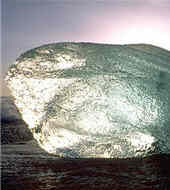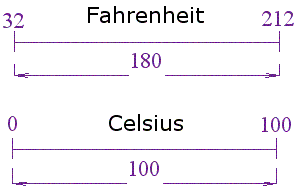CONVERSION DE GRADOS CELSIUS A FAHARENHEIT
Hay sobre todo dos escalas de temperatura que se usan en el mundo: la escala Fahrenheit (usada en EEUU), y la escala Celsius (parte del Sistema Métrico, usada en casi todos los demás países)
Las dos valen para medir lo mismo (¡temperatura!), sólo con números diferentes.
- Si congelas agua, la escala Celsius marca 0°, pero la Fahrenheit marca 32°.
- Si hierves agua, la escala Celsius marca 100°, pero la Fahrenheit marca 212°.
- La diferencia entre congelar y hervir agua es 100° Celsius, pero 180° Fahrenheit.
| Congelar | ... o ... | Hervir |
|---|---|---|
 |  |  |
Método de conversión
Mirando el diagrama vemos que:
- Las escalas empiezan con valores diferentes (32 y 0), así que tendremos que sumar o restar 32
- Las escalas suben a diferente ritmo (180 y 100), así que también necesitamos multiplicar
Y así funciona:
| Para convertir de Celsius a Fahrenheit, primero multiplica por 180/100, |
| Para convertir de Fahrenheit a Celsius, primero resta 32, después multiplica por 100/180CELSIUS CONVERSION TO FAHARENHEIT There are primarily two temperature scales used in the world: the Fahrenheit scale (used in USA), and the Celsius scale (part of the Metric System, used in most other countries) Both are worth to measure the same (temperature!), Only with different numbers. If you freeze water, 0 ° Celsius mark, but the mark 32 ° Fahrenheit. If you boil water, the scale reads 100 ° Celsius, but 212 ° Fahrenheit mark. The difference between freezing and boiling water is 100 ° Celsius, but 180 ° Fahrenheit. Freeze ... or ... boil Conversion method Looking at the diagram we see that: The scales begin with different values (32 and 0), so we have to add or subtract 32 Scales up at different rates (180 and 100), so we also need to multiply How it works: To convert from Celsius to Fahrenheit, first multiply by 180/100, then add 32 To convert from Fahrenheit to Celsius, first subtract 32, then multiply by 100/180
CONVERSIÓN DE GRADOS RANKINE A KELVIN
Se denomina Rankine (símbolo R) a la escala de temperatura que se define midiendo en grados Fahrenheit sobre el cero absoluto, por lo que carece de valores negativos. Esta escala fue propuesta por el físico e ingeniero escocés William Rankine en 1859.
El grado Rankine tiene su punto de cero absoluto a −459,67 °F, y los intervalos de grado son idénticos al intervalo de grado Fahrenheit.
Cero Rankine (0 R) equivalen a −273,15 °C ó 0 K. Para convertir de grados Kelvin a Rankine se multiplica por un factor de 9/5:
Usado comúnmente en EE.UU. como medida de temperatura termodinámica. Aunque en la comunidad científica las medidas son efectuadas en Sistema Internacional de Unidades, por tanto la temperatura es medida en kelvin (K).
CONVERSION OF DEGREES KELVIN RANKINE A
It is called Rankine (symbol R) to the temperature scale defined by measuring in Fahrenheit above absolute zero, so that no negative values. This scale was proposed by the Scottish physicist and engineer William Rankine in 1859. The degree Rankine has its point of absolute zero at -459.67 ° F, and the degreeintervals are identical to the interval of one degree Fahrenheit. Rankine zero (0 R) is equivalent to -273.15 ° C or 0 K. To convert degrees Kelvin toRankine is multiplied by a factor of 9/5: Commonly used in U.S. as a measure of thermodynamic temperature. Although thescientific community measures are carried out in the International System of Units, so thetemperature is measured in kelvins (K |






esto esta muy dificil
ResponderEliminarsi esta un poco dificil
Eliminarpero esta bien!
ResponderEliminarok gracias
Eliminarexelente tu información compañero
ResponderEliminarmuchas gracias compañero
ResponderEliminar